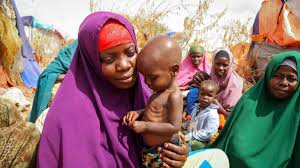The two challenges of global warming and population growth are related, but not as close as one might imagine, according to scientists.
According to estimates by the United Nations and other experts, the world’s eighth billionth person will be born on Tuesday somewhere. Since the population reached 4 billion in 1974, the Earth has warmed by almost 0.9 degrees Celsius (1.6 degrees Fahrenheit).
Scientists and officials are divided on the topic of population and climate.
Numerous climate and population experts told reporters that while more people using energy, primarily from the burning of fossil fuels, is warming the world; the real problem is how a small percentage of those people are contributing far more than their fair share of carbon pollution.
Director of the Global Economics Center at the World Resources Institute, Vanessa Perez-Cicera, stated that “we do have a population problem and we do have a population crisis.” But the biggest problem is overconsumption, in my opinion.
The 8 billionth child will “not have what we had” as a result, she added, because there aren’t enough resources.
There are 55 million people living in Kenya, which is experiencing a severe drought. This is 95 times more people than live in Wyoming. Wyoming, meanwhile, produces 3.7 times as much carbon dioxide as Kenya. While the United States has 4.5% of the world’s population but has produced 21.5% of the planet’s heat-trapping carbon dioxide since 1959, Africa as a whole has 16.7% of the world’s population but historically emits only 3% of the world’s carbon pollution.
More than ten times as much carbon dioxide is released into the atmosphere by the typical Canadian, Saudi, and Australian as compared to the ordinary Pakistani where one-third of the country was inundated due to a climate change-related disaster. And according to the World Bank, Pakistan’s per capita emissions are 20 times higher than Qatar’s.
Climate scientist Bill Hare of Climate Analytics stated that consumption patterns are the key issue rather than population size. “Therefore, it’s preferable to start by looking at the major northern emitters.”
Scientists at Climate Interactive examined the impact population has on climate change by running complex computer simulations that can be altered to see what elements are most important. It was discovered that its influence was little in comparison to other elements, such as the economy.
Only 0.2 degrees Celsius (0.4 degrees Fahrenheit) separated the two United Nations population projection scenarios of 8.8 billion and 10.4 billion people, according to Drew Jones of Climate Interactive. However, there was only a 0.7 degree Celsius difference between $100 per ton and no price or tax on carbon (1.3 degrees Fahrenheit).
According to Hare, the notion that overpopulation is the primary cause of climate change contains more than a hint of racism.
According to Katharine Hayhoe, chief scientist at The Nature Conservancy, “One of the major arguments I hear almost exclusively from men in high-income countries is that, ‘Oh, it’s simply a population problem.” Nothing is farther from the truth”.
According to Hayhoe, “50% of the world’s poorest people have historically produced 7% of heat-trapping gas emissions.” However, when it comes to which nations are most affected by climate change, Malawi, Mozambique, Senegal, and Afghanistan topped the list.
The richest people pollute more carbon even inside nations, according to Hare. 80% of the world’s population, he claimed, “emits a minuscule fraction of emissions overall.”
According to Colette Rose, project coordinator at the Berlin Institute for Population and Development, sub-Saharan Africa and south Asia “are contributing the least to man-made climate change” while also being home to the majority of the world’s population growth.
Between now and 2050, eight countries—five in Africa and three in Asia—will account for at least half of the population growth, according to Rose. They are the Democratic Republic of the Congo, Egypt, Ethiopia, Tanzania, Nigeria, Pakistan, India, and the Philippines.
According to Rose, the rate of population increase around the world has significantly decreased to less than 1% yearly and will probably peak at some point this century. However, this year’s carbon emissions are increasing 1% quicker than they were in 2021.
Concerns about population growth and climate change have been raised by environmental advocacy groups and government officials.
Nobody has sought to address the population issue from the outset. Too politically sensitive according to Joanna Depledge a climate historian from Cambridge University in England. Population growth is primarily concentrated in non-white populations, of course, but there are many dimensions, particularly in relation to religion and accusations of racism.
The Sierra Club pushed population control initiatives for a long time before looking more closely at the problem and breaking down the statistics, according to the organization’s president, Ramon Cruz. They discovered that the issues were more related to excessive consumption and the usage of fossil fuels, and he said that these issues would still exist “at 6 billion, 7 billion, or 8 billion” people.
When the world population reached 7 billion people 11 years ago, the Center for Biological Diversity produced special condoms with population and environmental messages like “Wrap with care, save the polar bear,” despite the fact that most environmental groups try to avoid the topic.

















